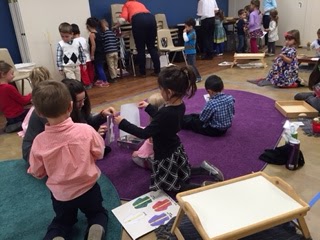Such an important message, especially in today's world, which has been talking "Christmas" for weeks now! I feel sad that our society, as a whole, misses the wonderful season of contemplative preparation!
So, as promised last week, thought I would share some photos of our work table and the various works that the children are doing during Advent. Some of these works aren't necessarily "religious" in nature. Their goal is to help the children build their motor skills (especially fine motor skills) while increasing their ability to concentrate for a growing period of time. As explained last week, this is an essential skill that many of us are losing today, yet it is a skill that is foundational to our ability to pray in a deep and meaningful way.
So, here are some of the works they will use in Advent. (I apologize that some of these photos are blurry! I was trying to quickly take some shots before the children arrived this morning.)
"Match the names of Jesus" work. These little plastic ornaments, in purple, pink and silver, have the many names of Jesus written on them. (One name on each ornament, such as "Light of the World," "Holy Child," etc. The children find the name with the ornament and place it on the laminated sheet next to the appropriate word. We have two sets of this work -- one with small ornaments, the other with larger ornaments.
"Decorate our Jesse tree work." Children can select small purple garland, beads and ornaments to decorate our little tree. On the third week of Advent, we add a few pink ornaments to the mix for Gaudete Sunday.
This work was so popular last week that I added a second small tree this week, so more children could decorate a tree if they wished. I also encourage them to make "Jesse tree" ornaments -- we have paper ornaments that they can color and add to the tree.
"Placing beads in small grooves on a mat." The children use a little spoon to move purple, oval-shaped beads from the small bowl to the mat. The second photo is a similar activity--they are moving round beads from the container to the grooved mat using the purple tongs.
"Learning to spell the word 'Advent" and "Emmanuel" The children match purple wooden letters to the letters on the Advent mat. When they have found the correct letter, they place it directly over the letter on the mat. The second photo gives them the opportunity to match the wooden letters to spell Emmanuel. Both activities also help them build vocabulary and letter recognition.
"Dry Erase Coloring the Word 'Advent'" The children use a purple dry erase marker to color in the word Advent, then they use the little included eraser to erase their coloring. They can repeat as many times as they like. It is interesting to watch the children concentrate while they do this, and they may repeat it several times, as if they are memorizing the letters!
"Sorting purple objects." The children use a little spoon or their fingers to move sort and categorize purple items of various shapes and textures. Some of the items include tiny purple blocks, sticks, pom-poms and triangles. Because they have a choice of how to move the materials, they are problem solving: could they move the sticks with the little spoon, or will they need to use their fingers to do it?
As mentioned earlier, many of these works may almost seem "secular" because they do not have any Biblical or spiritual underpinings. However, they are still building a very important skill for the children. As their concentration levels and ability with these practical works increase, we find that they spend less time on these materials and more time on some of the more "spiritual" works.
*************************
The other thing we did today: while the children were working individually on these various works, I pulled small groups of children aside and presented the Annunciation material to them. I use a small diorama of Mary's home with figures of Mary and the Angel Gabriel. I read Luke's passage about the Annunciation to them, we discussed the passage, and then I read the passage again, using the figures. I wish I could have taken photos of the children while I was presenting the material (but that would have distracted them too much!) The wonder and joy I saw in their faces, at the thought of an angel appearing to Mary and telling her the great news that she was going to have the baby Jesus!
It is amazing in many ways. I read to them directly from a regular Bible (not a children's Bible), and as you know, a regular Bible is often filled with big words they don't know. Yet they remain attentive to the words and their eyes watch me closely as I read from the Bible. I might explain a few words here and there, but sometimes this seems almost unnecessary. They may not have the vocabulary to give me a definition of the meaning of the complicated words, but they still understand the story and love it. I can see it in their faces!
I feel so blessed to do this work with your children each week, and to watch as they discover the beauty and miracles that God gives us every day!
*******************************
We're off for three weeks for the Christmas holiday. Our next session will be 1/10/16, when we'll do a meditation on the Nativity.
*******************************
Wishing you and your families a joyous holiday season!
Blessings,
Cheryl


















































